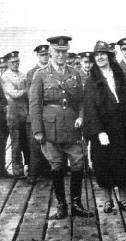Robert Whigham
| Sir Robert Whigham | |
|---|---|
 General Sir Robert Whigham | |
| Born | 5 August 1865 |
| Died | 23 June 1950 (aged 84) |
| Allegiance |
|
| Service/branch |
|
| Years of service | 1883–1931 |
| Rank | General |
| Commands held |
Eastern Command 3rd Division Light Division British Army of the Rhine 62nd (2nd West Riding) Division 59th (2nd North Midland) Division |
| Battles/wars | First World War |
| Awards |
Knight Grand Cross of the Order of the Bath Knight Commander of the Order of St Michael and St George Distinguished Service Order Mentioned in Despatches (4) Legion of Honour (France) |
General Sir Robert Dundas Whigham, GCB, KCMG, DSO (5 August 1865 – 23 June 1950) was a British Army officer and a former Adjutant-General to the Forces.
Military career
Educated at Fettes College in Edinburgh and at the Royal Military College, Sandhurst, Robert Whigham was commissioned into the 1st Battalion Royal Warwickshire Regiment as a lieutenant on 9 May 1885.[1]
He was promoted to captain on 3 March 1892, when he became Adjutant for the Royal Warwickshire Regiment, and was seconded to the Egyptian Army in 1897, where he served in the Nile Expedition of 1898 with the 12th Sudanese Battalion.[1] During the Second Boer War he served first 1899–1900 as Aide-de-camp to Major-General Hector MacDonald, in command of the Highland brigade, and was promoted to major on 1 August 1900. He was later at Army Headquarters in South Africa, and for his service was appointed a Companion of the Distinguished Service Order (DSO) in the South Africa Honours list published on 26 June 1902.[2][1] Following the end of the war, he returned to the United Kingdom in August 1902,[3] and then became Brigade Major for 2nd Army Corps in November 1902.[1]
He also served in the First World War with the British Expeditionary Force.[1] He was appointed Deputy Chief of the Imperial General Staff at the War Office in 1915.[1] He became General Officer Commanding 59th (2nd North Midland) Division in June 1918 and GOC 62nd (2nd West Riding) Division in August 1918.[1][4][5]
After the War he became General Officer Commanding of the Light Division in the British Army of the Rhine.[1] He was appointed General Officer Commanding 3rd Division in 1919,[6] Adjutant-General to the Forces in 1923[7] and General Officer Commanding-in-Chief for Eastern Command in 1927.[8] He retired in 1931.[9]
Family
In 1899 he married Isabel Adeline Muntz.[1]
References
- 1 2 3 4 5 6 7 8 9 Anglo Boer War
- ↑ "No. 27448". The London Gazette (Supplement). 26 June 1902. pp. 4191–4192.
- ↑ "The War - Return of Troops". The Times (36842). London. 9 August 1902. p. 11.
- ↑ Maj A.F. Becke,History of the Great War: Order of Battle of Divisions, Part 2b: The 2nd-Line Territorial Force Divisions (57th–69th), with the Home-Service Divisions (71st–73rd) and 74th and 75th Divisions, London: HM Stationery Office, 1937/Uckfield: Naval & Military Press, 2007, ISBN 1-847347-39-8, pp. 17, 41
- ↑ Maj A.F. Becke,History of the Great War: Order of Battle of Divisions, Part 4: The Army Council, GHQs, Armies, and Corps 1914–1918, London: HM Stationery Office, 1944/Uckfield: Naval & Military Press, 2007, ISBN 1-847347-43-6, p. 2.
- ↑ Army Commands
- ↑ An account of the unveiling of the Royal Air Force Memorial 16 July 1923
- ↑ Flight Global 18 August 1927
- ↑ Whitaker's Almanack 1931
| Military offices | ||
|---|---|---|
| Preceded by Sir Launcelot Kiggell |
Deputy Chief of the Imperial General Staff 1915–1918 |
Succeeded by Sir Charles Harington |
| Preceded by Cyril Deverell |
General Officer Commanding the 3rd Division 1919–1922 |
Succeeded by William Heneker |
| Preceded by Sir Philip Chetwode |
Adjutant General 1923–1927 |
Succeeded by Sir Walter Braithwaite |
| Preceded by Sir Walter Braithwaite |
GOC-in-C Eastern Command 1927–1931 |
Succeeded by Sir Webb Gillman |